Overview
The article primarily emphasizes the crucial types of commercial mirrors for bathrooms that significantly enhance design. It underscores that mirrors such as low-iron, copper-free, and antique-style options not only elevate aesthetic appeal but also fulfill essential functional needs. These mirrors are vital components in contemporary bathroom design, as demonstrated by successful installations in various commercial projects. Furthermore, their integration not only contributes to the overall ambiance but also reflects a commitment to quality and style.
Introduction
The bathroom transcends its role as a mere functional space; it emerges as a sanctuary where design harmonizes with utility. As architects and designers increasingly acknowledge the transformative power of mirrors, selecting the right one can significantly enhance not only the aesthetic appeal but also the overall experience of the restroom.
With a plethora of options available—from vibrant colored glass to sustainable copper-free surfaces—how can one effectively navigate this diverse landscape to choose the ideal commercial mirrors for bathrooms?
This article explores nine essential types of mirrors that promise to elevate bathroom design, providing insights into their unique benefits and the latest trends shaping the industry.
The Splash Lab: Premium Commercial Mirrors for Enhanced Bathroom Design
The Splash Lab excels in providing high-quality commercial mirrors for bathrooms that not only fulfill functional requirements but also significantly enhance the aesthetic appeal of bathroom spaces. Each reflective surface is meticulously crafted to ensure durability and ease of maintenance, making them suitable for a variety of bathroom styles. Recent trends indicate a growing preference for commercial mirrors for bathrooms, which feature reflective surfaces equipped with built-in LED lighting and adjustable features, transforming the ambiance of any bathroom. For instance, reflective surfaces integrated with RGB LED lights allow users to create dynamic environments that cater to diverse aesthetic tastes.
Architects recognize the vital role that commercial mirrors for bathrooms play in design, often highlighting their ability to augment a sense of space and illumination. Successful projects, such as those executed for Padel Haus in New York and Lacuna Space in California, exemplify how The Splash Lab's premium reflections elevate contemporary bathroom design while addressing specific client needs. Research indicates that well-designed commercial mirrors for bathrooms can enhance user satisfaction and improve the overall restroom experience, positioning The Splash Lab as a preferred partner for architects and designers seeking innovative solutions. With a strong focus on sustainability and customization, The Splash Lab continues to lead the way in enhancing bathroom aesthetics through its exceptional reflective products.
Furthermore, the global bathroom cabinet market is projected to exhibit a CAGR of 4.42% from 2025 to 2033, underscoring the growing importance of innovative designs in commercial settings. As noted by Brent Otsuka, Manager of Interior Design at Fentress Architects, The Splash Lab is often the top choice for developing well-designed facilities, reinforcing its esteemed reputation within the industry.
Colored Mirror Glass: Adding Vibrancy to Commercial Spaces
Tinted reflective glass serves as a distinctive method for infusing liveliness into commercial mirrors for bathrooms. Available in an array of hues, these mirrors can create focal points or seamlessly complement existing color schemes. Particularly effective in hospitality settings, where crafting a memorable experience is paramount, they elevate the overall aesthetic.
As Brent Otsuka, Manager of Interior Design at Fentress Architects, observes, "The Splash Lab has well crafted and beautifully designed products. I always go to them first to create a holistically designed bathroom."
By selecting the right colors, designers can evoke specific moods—such as calmness or energy—enhancing the space's overall appeal. The offerings from The Splash Lab, including commercial mirrors for bathrooms, represent an ideal choice for architects looking to elevate bathroom design.
Low-Iron Mirrors: Achieving Crystal Clear Reflections
Low-iron glass surfaces are engineered to eliminate the green hue commonly associated with standard glass options, providing crystal-clear reflections that significantly enhance the aesthetic appeal of commercial mirrors for bathrooms. This clarity proves particularly advantageous in upscale settings, such as luxury hotels and high-end retail spaces, where visual integrity is of utmost importance.
Designers are increasingly opting for low-iron glass in the creation of commercial mirrors for bathrooms due to its capacity to elevate restroom aesthetics, ensuring that every detail contributes to a sophisticated atmosphere. As Greg Martell articulates, acknowledging the importance of aesthetics alongside utility can aid in selecting the most appropriate reflection for a client’s environment.
The rising market demand for commercial mirrors for bathrooms underscores a burgeoning trend toward quality and elegance in commercial aesthetics, with advancements in low-iron technology further enhancing their performance and durability. Furthermore, copper-free reflective surfaces excel in high-moisture areas, ensuring both durability and efficiency.
By incorporating low-iron glass and commercial mirrors for bathrooms, facilities can cultivate an inviting and visually striking washroom experience that resonates with users and aligns with contemporary design standards. Successful implementations of low-iron reflective surfaces in upscale retail environments exemplify their significant impact on enhancing overall restroom aesthetics.
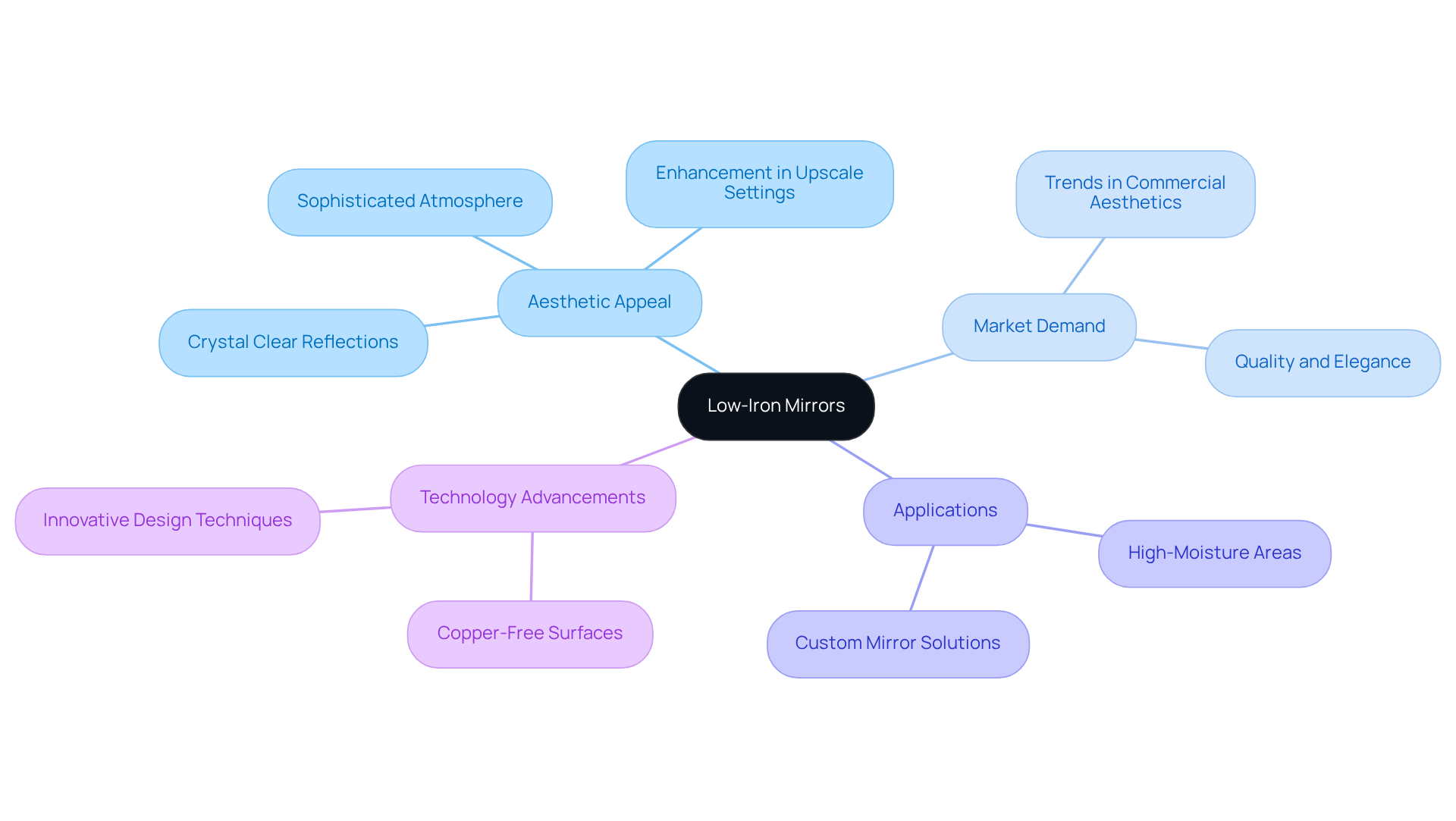
Copper-Free Mirrors: Sustainable Choices for Commercial Bathrooms
Copper-free reflectors represent a superior choice for environmentally conscious projects, providing both longevity and aesthetic appeal. Unlike conventional reflective surfaces that often include copper, which can oxidize and create unattractive marks, copper-free alternatives resist decay over time. This results in reflective surfaces that maintain their clarity and brilliance while supporting a sustainable environment. In commercial settings, choosing commercial mirrors for bathrooms with copper-free reflective surfaces is a wise investment due to their extended lifespan compared to traditional options.
Environmental designers frequently advocate for copper-free reflective surfaces, which are beneficial in reducing maintenance costs and enhancing the aesthetics of commercial mirrors for bathrooms. As Brent Otsuka, Manager of Interior Design at Fentress Architects, observes, "The Splash Lab has well-crafted and beautifully designed products. I always go to them first to create a holistically designed bathroom." By selecting these reflective surfaces, designers align with The Splash Lab's commitment to quality craftsmanship and sustainability, ensuring their projects not only meet aesthetic standards but also promote eco-friendly practices.
Examples of eco-friendly reflective options in business environments include:
- Commercial mirrors for bathrooms made with recycled materials
- Energy-efficient manufacturing methods
This underscores the importance of sustainability in contemporary restroom design.
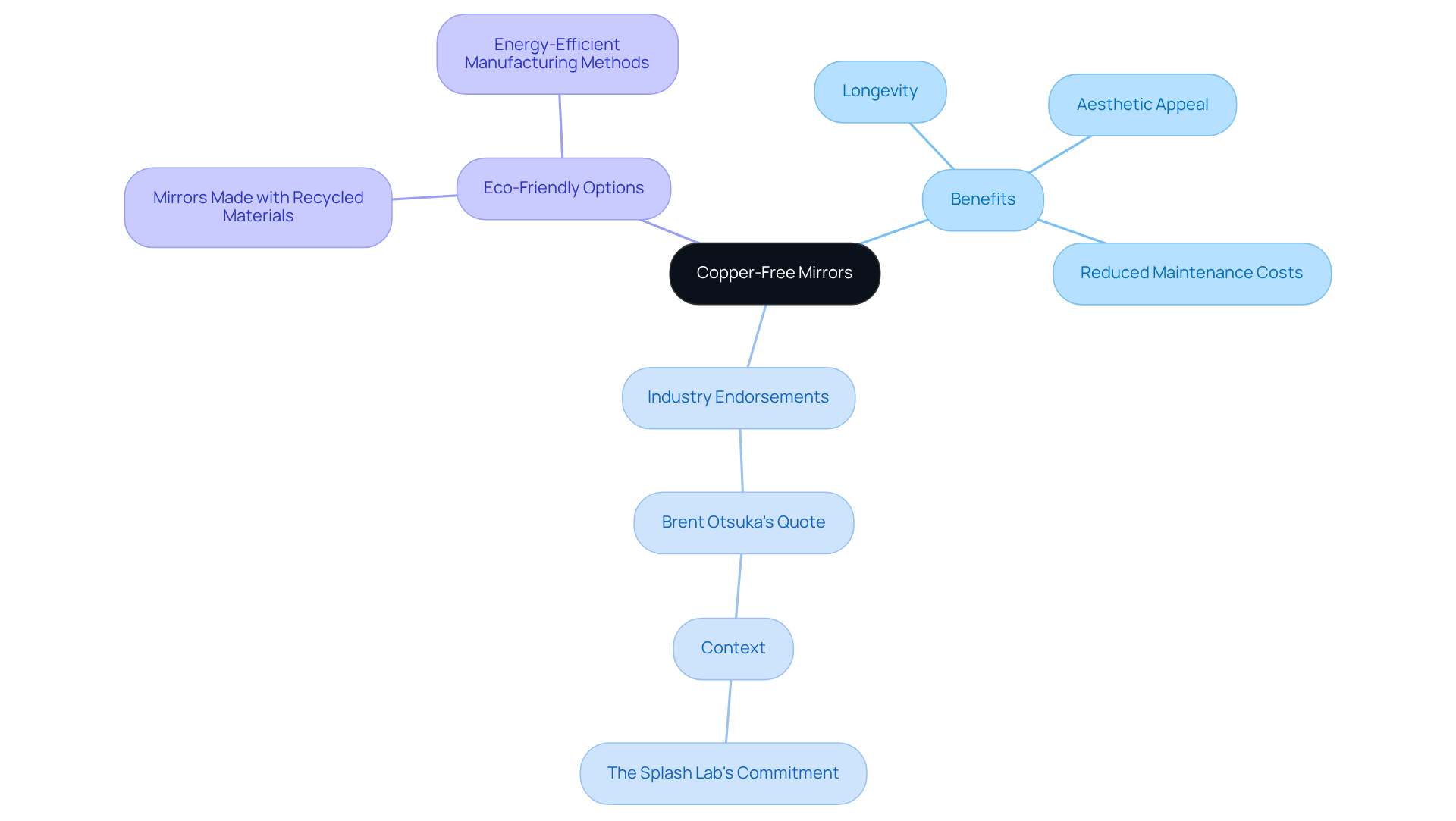
Antique-Style Mirrors: Infusing Character into Bathroom Spaces
Antique-style reflections impart a profound sense of history and elegance to commercial bathrooms. These surfaces, particularly commercial mirrors for bathrooms, serve not only as statement pieces but also as focal points that elevate the overall design narrative of the space. Ideal for boutique hotels and restaurants, vintage glass can be artfully combined with contemporary fixtures, creating a striking contrast that captivates users and enriches their experience. Furthermore, the integration of such elements not only enhances visual appeal but also invites a deeper appreciation of the space's character.
One-Way Mirrors: Balancing Privacy and Design
One-way glass serves as a cutting-edge solution for ensuring privacy in commercial facilities. These reflective surfaces enable individuals indoors to observe the outside world while obstructing visibility from the exterior, making them ideal for bustling environments such as airports and shopping centers, where privacy is paramount. By integrating commercial mirrors for bathrooms into designs, architects and designers can significantly enhance user comfort without sacrificing visual appeal.
The benefits of one-way glass extend beyond mere privacy; they contribute to a more open ambiance in compact restroom areas. Their reflective qualities can create an illusion of depth, making smaller spaces feel larger and more welcoming. Moreover, the incorporation of commercial mirrors for bathrooms can reduce the need for extensive wall partitions, streamlining the design process and lowering construction costs.
Numerous commercial ventures exemplify the successful application of one-way glass, strategically positioned to optimize both functionality and aesthetics. For instance, in the Padel Haus project in New York, The Splash Lab utilized commercial mirrors for bathrooms along with one-way glass to elevate the bathroom experience, allowing natural light to permeate while maintaining privacy. This innovative approach not only met the specific needs of the facility but also aligned with contemporary design trends, underscoring the versatility and effectiveness of one-way glass in modern restroom environments.
As the demand for sustainable and energy-efficient bathroom solutions continues to rise, incorporating commercial mirrors for bathrooms can be part of a broader strategy to develop eco-friendly washroom options. Designers must also consider potential challenges, such as ensuring compliance with safety regulations and the optimal arrangement of reflective surfaces to maximize natural light while safeguarding privacy.
For architects and designers, it is essential to evaluate the layout of restroom areas and strategically position commercial mirrors for bathrooms to enhance both functionality and aesthetics, ultimately fostering a more inviting atmosphere.
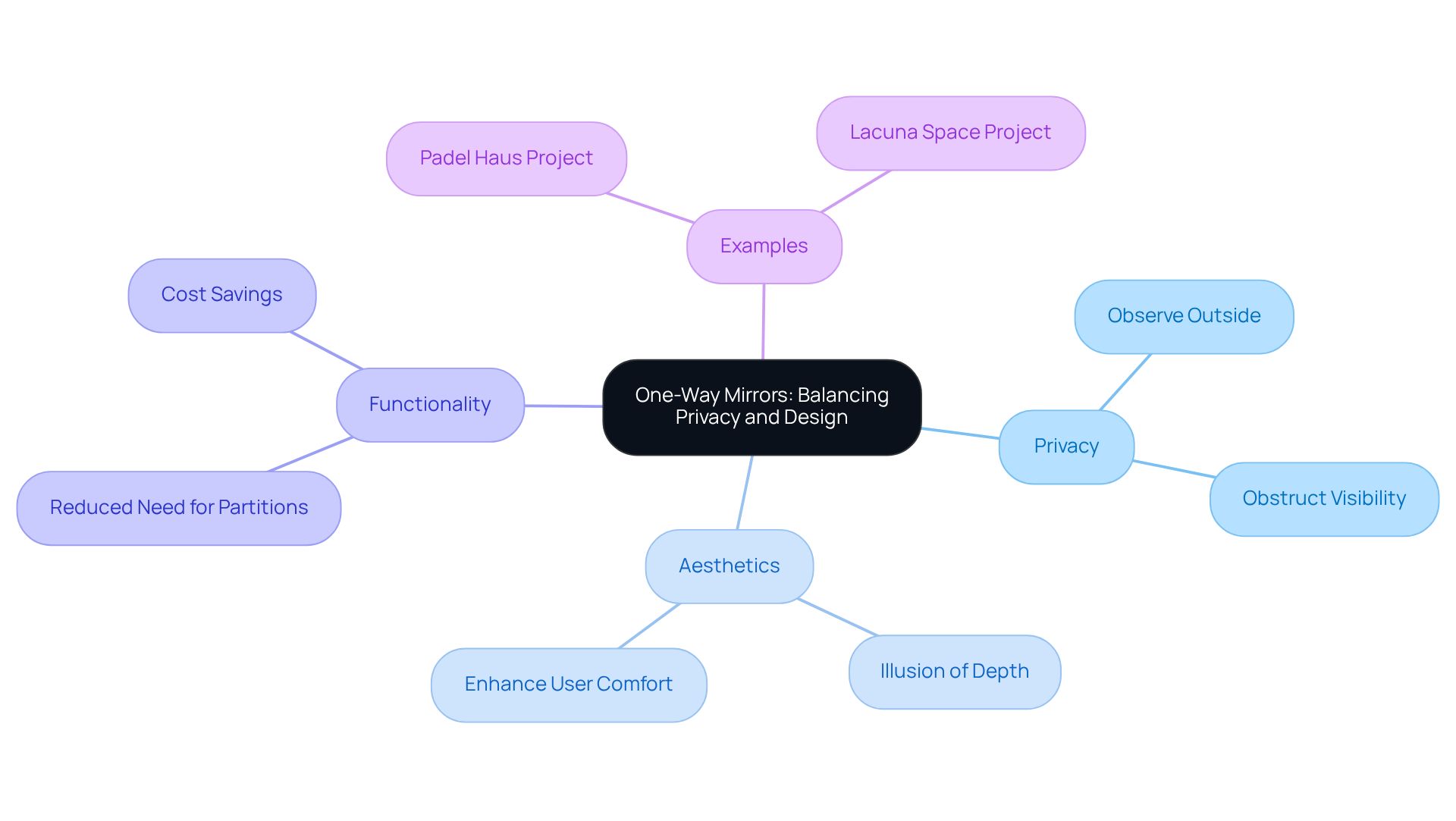
Mirror Size Considerations: Optimizing Space and Functionality
Choosing the appropriate dimensions for commercial mirrors for bathrooms is essential for maximizing both space and utility. Commercial mirrors for bathrooms not only create an illusion of increased space with their larger reflective surfaces but also enhance the luminosity of the area, making it feel more inviting. For instance, initiatives such as Padel Haus in New York demonstrate how the strategic implementation of expansive reflective surfaces can elevate the overall restroom experience, resonating with the dynamic lifestyles of users.
However, achieving the right balance between the size and functionality of commercial mirrors for bathrooms is crucial. To ensure they do not obstruct movement or accessibility, commercial mirrors for bathrooms must be proportionate to surrounding fixtures. For a 24-inch vanity, a reflective surface width of 22 to 23 inches is recommended. For a 30-inch vanity, the ideal width is 28 to 29 inches, while larger vanities, such as those measuring 60 inches, should feature reflective surfaces that are 58 to 59 inches wide. This proportionality not only enhances the aesthetics of commercial mirrors for bathrooms but also ensures practical usability.
The height at which reflective surfaces are installed is another critical factor. Ideally, the center of the reflective surface should be positioned at eye level, approximately 57 to 60 inches from the finished floor, accommodating users of varying heights. In double sink vanities, this same height guideline applies, whether utilizing a single large reflective surface or two smaller ones.
Furthermore, incorporating creative lighting can significantly enhance the functionality and visual appeal of commercial mirrors for bathrooms. For taller ceilings, tall and narrow mirrors paired with side sconces are recommended, while rectangular mirrors can be complemented with ceiling pendants for a modern aesthetic. As highlighted by industry specialists, 'the finest rooms reflect the individuals who inhabit them,' underscoring the importance of deliberate selection of elements. By prioritizing these considerations, architects and designers can create business restrooms that include commercial mirrors for bathrooms, ensuring they are both functional and visually pleasing. A practical takeaway is to always measure the vanity and consider the surrounding fixtures before selecting a reflective surface to ensure a harmonious design.
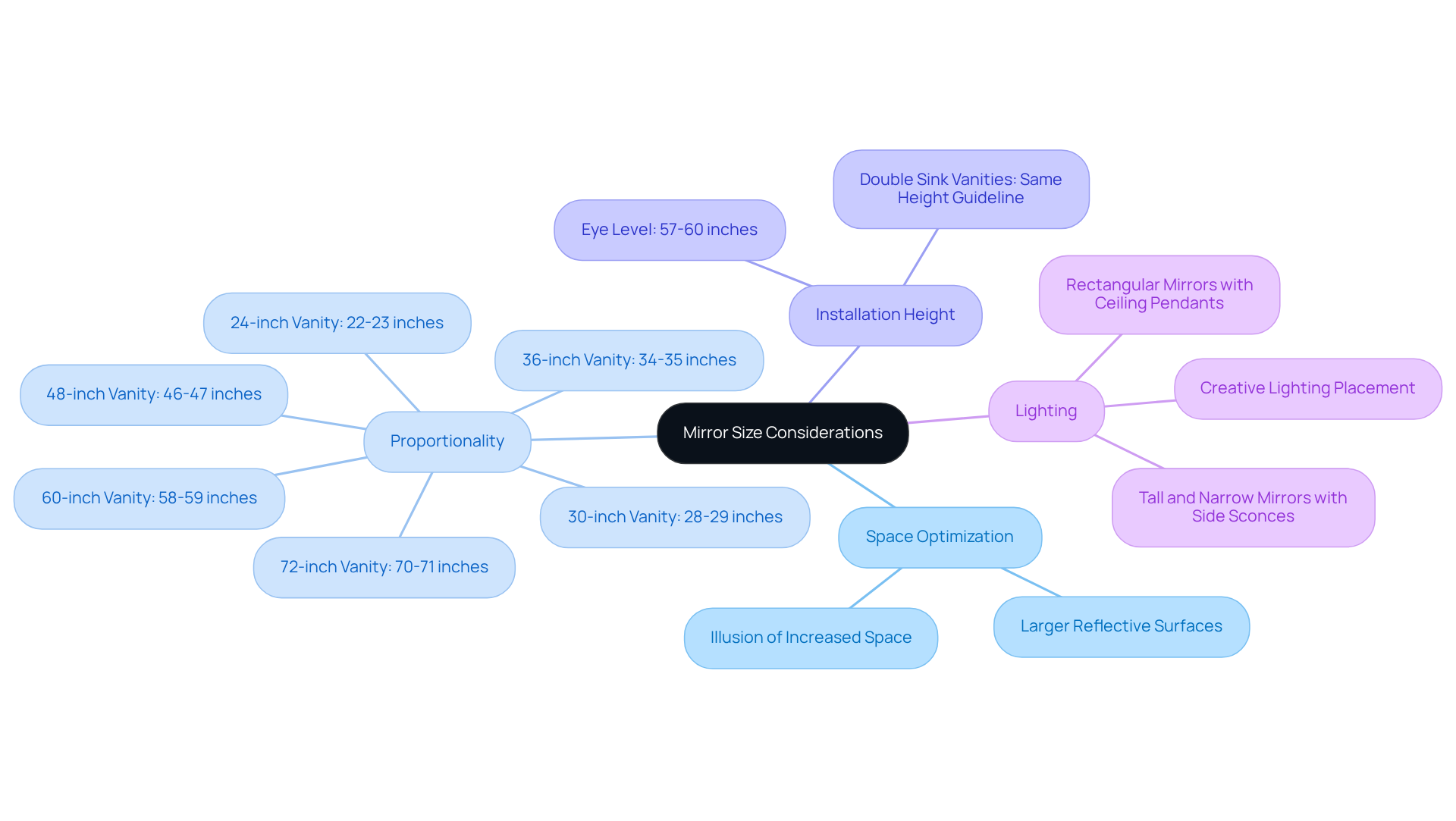
Commercial Mirror Installation: Best Practices for Longevity
Proper installation is essential for the longevity of commercial mirrors for bathrooms. Secure installation using suitable hardware is crucial to avoid accidents and damage; statistics indicate that a significant portion of glass breakage is linked to insufficient mounting methods. Mirrors should be positioned to facilitate easy cleaning and maintenance, preserving their appearance and extending their lifespan.
Adhering to manufacturer guidelines is essential, and seeking advice from experts during installation can further enhance safety and longevity, ensuring that reflective surfaces remain a functional and aesthetic asset in any restroom environment. As Kenneth Recibas observes, choosing reflective surfaces made from tempered glass, which is shatterproof and scratch-resistant, greatly enhances their durability and safety.
It is advised that reflective surfaces possess a glass thickness of no less than 5-6 mm for maximum durability. Furthermore, reflective surfaces should be positioned to avoid direct sunlight to prevent glare. Routine cleaning with gentle cloths and mild solutions is crucial for prolonging the durability of reflective surfaces.
Investing in quality installation methods not only safeguards the reflective surfaces of commercial mirrors for bathrooms but also enhances the overall bathroom experience. Successful setups, like those at Padel Haus and Lacuna Space, showcase the beneficial effect of the correct placement of commercial mirrors for bathrooms on washroom environments.

Mirror Maintenance Tips: Ensuring Longevity and Clarity
Maintaining commercial glass surfaces is essential for ensuring their longevity and clarity. Regular cleaning with non-abrasive solutions not only prevents buildup that can obscure reflections but also enhances the overall aesthetic of the restroom. Facility managers should establish a routine maintenance schedule that includes periodic inspections for signs of damage or corrosion, particularly in high-moisture environments.
Statistics indicate that reflective surfaces can endure considerably longer—up to 30% more—when properly maintained, underscoring the importance of proactive care. Furthermore, effective maintenance practices can lead to a 20% time savings, as noted in the context of CMMS technology. As one facility manager insightfully remarked, 'Investing time in maintenance of reflective surfaces pays off in the long run, both in appearance and functionality.'
By prioritizing these maintenance strategies, facility managers can ensure that reflective surfaces remain pristine and functional, contributing to a positive restroom experience. In addition, gaining knowledge from the experiences of other facility managers can provide valuable insights into best practices for maintenance.
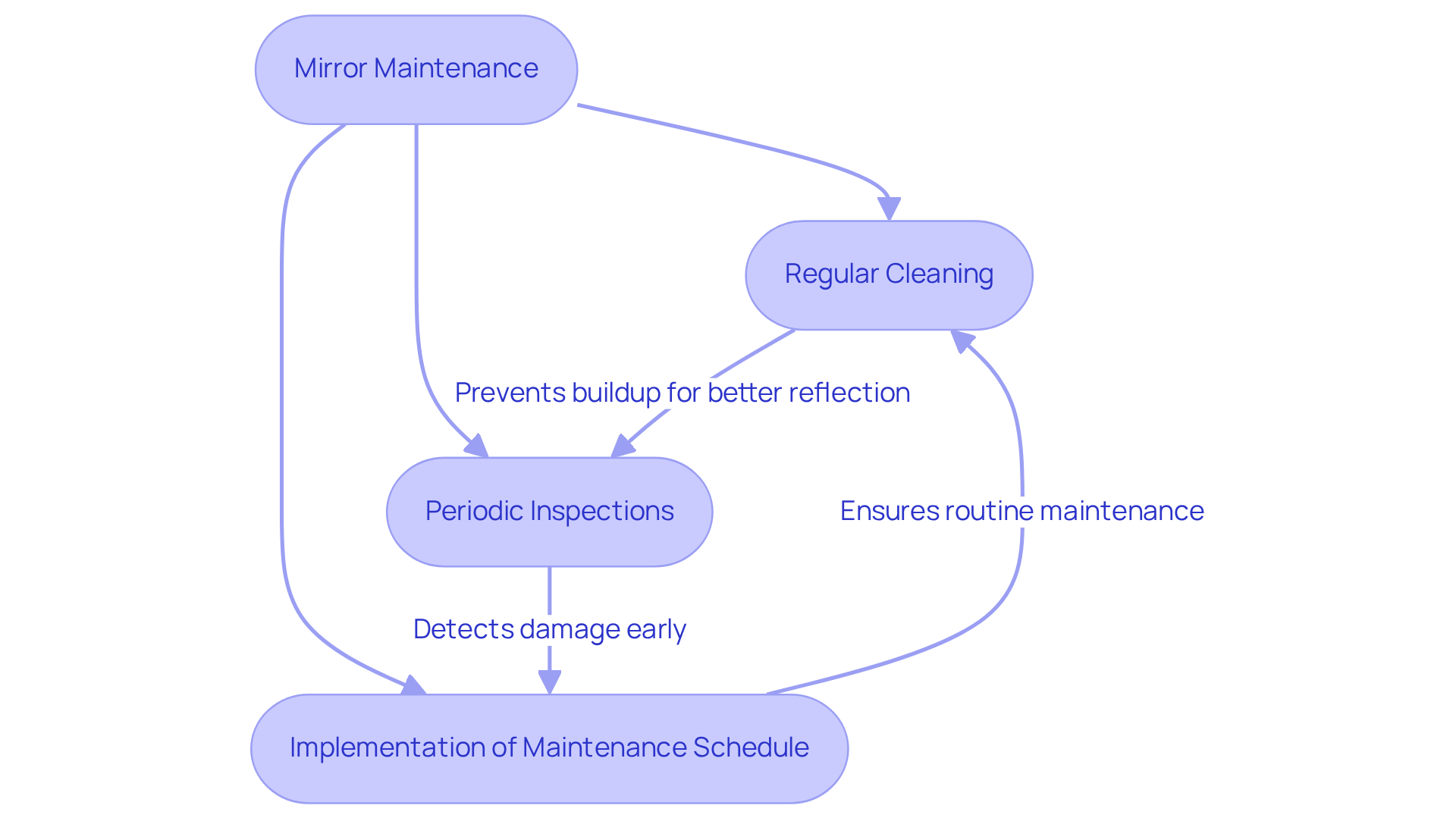
Cost Considerations: Budgeting for Commercial Mirrors
When budgeting for commercial glass, it is essential to consider not only the initial purchase price but also the installation and maintenance expenses. Various types of reflective surfaces, such as low-iron or antique-style glass, come with differing price points. Furthermore, investing in superior-quality reflective surfaces can lead to long-term savings by reducing the necessity for replacements and repairs.
The typical expense for standard bathroom glass installations ranges from $120 to $250, while the cost for glass replacement varies from $150 to $350, averaging around $225. Clients should collaborate closely with suppliers like The Splash Lab to grasp the full scope of costs associated with their mirror selections.
It is also crucial to hire licensed electricians for complex installations to ensure safety and compliance with local codes. As Jacob Lew noted, "The budget is not just a collection of numbers, but an expression of our values and aspirations," underscoring the significance of a well-structured budget that reflects both immediate needs and future aspirations.

Conclusion
The significance of commercial mirrors in bathroom design is paramount, serving both functional and aesthetic roles. By carefully selecting the appropriate types of mirrors—such as low-iron, copper-free, or antique-style—designers can greatly enhance the overall ambiance and user experience in commercial restroom environments.
This article has delved into various facets of commercial mirrors, highlighting the increasing trend toward sustainable and innovative designs. It has explored the effects of colored and one-way mirrors on privacy and aesthetics, alongside essential considerations regarding size and installation. Each point underscores how meticulous mirror selection and placement can transform ordinary bathrooms into visually striking and efficient spaces.
In conclusion, integrating premium commercial mirrors is an essential step for architects and designers intent on elevating bathroom environments. By embracing contemporary trends and prioritizing sustainability, they not only enhance aesthetic appeal but also foster a more inviting and functional restroom experience. Investing in high-quality reflective surfaces and adhering to best practices in installation and maintenance will yield evident long-term benefits for both users and facilities.
Frequently Asked Questions
What types of mirrors does The Splash Lab offer for commercial bathrooms?
The Splash Lab offers high-quality commercial mirrors that enhance bathroom design, including reflective surfaces with built-in LED lighting, adjustable features, and tinted reflective glass.
How do commercial mirrors from The Splash Lab enhance bathroom aesthetics?
These mirrors are designed to augment a sense of space and illumination, transforming the ambiance of bathrooms and allowing for customization to cater to diverse aesthetic tastes.
Can you provide examples of successful projects that utilized The Splash Lab's mirrors?
Successful projects include installations for Padel Haus in New York and Lacuna Space in California, showcasing how The Splash Lab's mirrors elevate contemporary bathroom design.
What is the significance of colored mirror glass in commercial spaces?
Tinted reflective glass adds vibrancy and can create focal points or complement existing color schemes, particularly enhancing hospitality settings to craft memorable experiences.
What are the benefits of using low-iron mirrors in commercial bathrooms?
Low-iron mirrors provide crystal-clear reflections by eliminating the green hue of standard glass, which is particularly advantageous in upscale settings where visual integrity is crucial.
Why are designers increasingly opting for low-iron glass in bathroom mirrors?
Designers choose low-iron glass to elevate restroom aesthetics and ensure that every detail contributes to a sophisticated atmosphere, especially in luxury environments.
How does The Splash Lab emphasize sustainability and customization in their products?
The Splash Lab focuses on sustainability by offering durable and efficient products, while also providing customization options to meet specific client needs.
What is the projected growth of the bathroom cabinet market and its relevance to commercial mirrors?
The global bathroom cabinet market is projected to grow at a CAGR of 4.42% from 2025 to 2033, highlighting the increasing importance of innovative designs, including commercial mirrors, in commercial settings.




